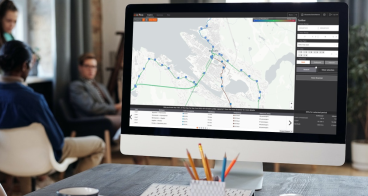Accelerating the digital transformation of European transport
A deep dive into the common European Mobility Data Space (EMDS) and strategic insights for the sustainable and smart mobility era – from concept to reality.
A key part of Europe’s digital strategy is enabling the access and sharing of transport and mobility data. After one year of collaborative efforts, PrepDSpace4Mobility project has published its main findings and recommendations regarding current challenges of and possible paths to the common European mobility data space (EMDS). Drawing on stakeholder engagement, surveys, and consultations with over 500 individuals in addition to analysing EU reference architectures for federated data sharing such as the International Data Spaces Association (IDSA), Gaia-X and iSHARE, the report provides recommendations and building blocks for foundational principles, technical developments, and business and governance models crucial for a successful EMDS.
The success and economic sustainability of a common EMDS depend on the value added for the multiple stakeholders in the ecosystem. This requires the alignment of its mission with the expectations and needs of the stakeholders.
One of the reasons mobility stakeholders might be hesitant to join data space initiatives is because of concerns around secure and sovereign data exchange. The governance framework for the EMDS should therefore offer a data sharing ecosystem for the multiple mobility data spaces that will emerge. It should support discoverability, data sovereignty and trust, and be coordinated by an impartial governance authority to administrate the data space. Privacy and data protection should be given utmost priority in the creation of the EMDS. It is necessary for the EMDS to foster trust, ensure legal compliance and uphold the EU values, while improving data quality and user empowerment.
Requiring all data space actors to use or migrate towards certain data models or standards from the outset will be very difficult and could result in a lack of acceptance. Moreover, it would contradict the principles of data sovereignty. Instead, the EMDS can embrace existing data models, which have evolved for specific reasons and serve well-justified purposes. Nevertheless, harmonisation should remain an important goal in achieving interoperability between these data models and standards.
Another key consideration is how the EMDS will be funded. To accelerate use cases, mechanisms to incentivise and support participants should be implemented. In order to facilitate adoption and ensure sustainability of the EMDS, public funding can be a useful tool to overcome potential barriers, especially in the initial stages.
Ensuring the viability of the EMDS business model relies on providing up-to-date technology, which requires continuous efforts to maintain its relevance over the long term. A common EMDS may adopt the Gaia-X/IDSA/Eclipse Dataspace Components technology already used by the Gaia-X lighthouse projects in the mobility sector from the beginning. The use of such European standard technology could allow a future common EMDS to connect to other data spaces and offer its members a continuously growing network of potential partners.
Crucial to both the technical and the strategic dimension of an EMDS business model is offering low-threshold access to the data space by providing easy-to-use technical components and instructions on how to get started. The most effective offer of easy technical onboarding is the “Connector-as-a Service”, which enables a data space connector to be readily prepared for download, installation and configuration within the premises of the participant.
To further understand current challenges and future opportunities of European mobility data spaces, EIT Urban Mobility, Factual, and i2CAT have recently published a report with a focus on private and public actors involved. Aligned with the European Commission's Data Strategy, the report positions data spaces as crucial ecosystems for sovereign and secure data sharing, particularly in the realm of mobility. By emphasising data as a strategic asset, it envisions enhanced road safety, alternative transportation modes, and advanced mobility services through secure and voluntary data sharing. Importantly, it lays down recommendations for companies, cities & regions, as well as national and EU to unlock the potential of mobility data spaces.
However, challenges loom in deploying and operating mobility data spaces. More than 80 % of respondents in a survey of over 70 practitioners struggle to access the data needed to deliver their services. The study scrutinises the transition from conceptual design to sustainable service models, accentuating the critical role of private sector interest and investment. Notably, the Gartner Hype Cycle places mobility data spaces in the early innovation phase, which leads to the need to assess their actual adoption rate.
The study concludes with useful recommendations for businesses, highlighting the potential for monetising mobility data and fostering new market segments. In this regard, it recommends to roll out more pilots to identify win-win business models, as well as thorough impact assessments of conducted projects in order to communicate about the benefits of MDS for the mobility ecosystem. It underscores the importance of data spaces in supporting regulatory compliance and harmonisation across diverse sectors. It also anticipates transformative impacts on the rail sector, digitalisation, and interoperability.
Mobility data spaces are seen as a catalyst for efficient, sustainable, and safe transportation in Europe, but questions remain about the widespread adoption and realisation of their promised potential. The report includes recommendations for developing mobility data spaces and use cases which will accelerate their realisation in the coming years.
What’s next: role and aim of deployEMDS
The European Commission aims to support the real-life implementation of mobility data spaces in the next years, as it transitions from conceptual design, to piloted innovation, to sustainable, in-production service model. The deployEMDS project, building upon the groundwork laid by PrepDSpace4Mobility, kicked off its activities in November at the Tomorrow.Mobility World Congress. 45 partners will demonstrate more than 20 use cases in nine cities and regions across Europe, using one harmonised technical infrastructure. The demonstrations are piloting suitable business models and common governance mechanisms for the use of large amounts of data in machine-readable format, setting an example for future initiatives and addressing the existing industry gap. This decentralised, trusted, and secure approach to data exchange is set to showcase the potential of mobility data. Data-based decision-making will improve local traffic management, create more convenient travel journeys for passengers, and simplify the process of designing and organising transportation infrastructure. The deployEMDS project is an essential component of Europe’s journey towards more efficient, inclusive, and sustainable mobility systems
We invite you to download both studies from the files section below, exploring the most recent insights, use cases and thorough recommendations for mobility data spaces.
Published on 22 November, 2023.






